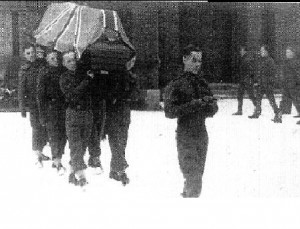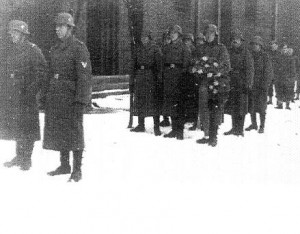End of 1941. early 1942
Michael Whiteman’s graphic account of his days as a German Prisioner of War.
I think it was about this time snow was on the ground one of our lads became ill. He was a lad from Hastings, in the 5th Sussex Regiment, twenty one years old, name Frank Smith. He died with blood poisoning, poor fellow. He was given a fill military funeral as the photos show.
 About the end of 1941, Red Cross parcels started to come along, at first when given our the guard was ordered to pierce each tin to stop us hoarding things in case we escaped. They got fed up with that and issued one parcel between two twice a week, which suited us very well. The box of food, as far as I can remember was 2oz tea, 2oz of cheese in a tin, then marge, 1 tin of jam or something to spread, 1 tin of meatloaf or other meat, a packet of boiled sweets, one tin of stew, 1 bar of soap, a lot of things were victimised or so it said. This extra food made a lot of difference to our well-being. Fifty cigs were given separately per week.
About the end of 1941, Red Cross parcels started to come along, at first when given our the guard was ordered to pierce each tin to stop us hoarding things in case we escaped. They got fed up with that and issued one parcel between two twice a week, which suited us very well. The box of food, as far as I can remember was 2oz tea, 2oz of cheese in a tin, then marge, 1 tin of jam or something to spread, 1 tin of meatloaf or other meat, a packet of boiled sweets, one tin of stew, 1 bar of soap, a lot of things were victimised or so it said. This extra food made a lot of difference to our well-being. Fifty cigs were given separately per week.
About this time new uniforms, overcoats and hats arrived, we really were back to a smart body of men, I handed back my Polish coat and hat and my blood stained uniform which you could still see from May 26th 1940 when it got soaked. Also early 1942 parcels from the family were allowed to be sent up to certain weight, every three months. Through these parcels over the whole time I received shorts, socks, pants, vests, a pair of boots, towels and always chocolate which all had to come from the coupon rations from the family. They did me well, all contributing.
We all worked six days a week. Sometimes morning shift six till two, or late shift two to ten, we showered at the pit baths so were clean to go home, and so the weeks passed, and so did the months. It became a routine. All the lads got on with each other, odd arguments soon fizzled out, and now the date was July 1943.
I think it was during the second week, I knew that the twelve foot high wall of coal on my right was making hollow cracking sounds, to me it wasn’t good. The German said it was OK, suddenly it did crash, I jumped to my left and I was pinned against the iron conveyor with a load of large coal lumps up to my waist. The conveyor was stopped, the overseer and my mate struggled to get the weight off my legs, my ankle was so swollen that they cut my boot off. The overseer tied a bandage round saying it was just a sprain. Two of my mates were told to carry me to the cage lift, about three quarters of a mile to go, after many stops and sweating until our clothes were wet, we got to the shaft and up we went. A guard was waiting at the top and I was sat down in the shower, my two mates scrubbed me down and so to the waiting for an ambulance and Hospital, very well organised. My leg was X-rayed, but had to wait a few days for the swelling to go down a little before plaster was put on. I spent seven weeks in there, being bathed by an eighteen year old Russian Medical Orderly. Another eighteen year old Russian lad was the only one alive when a cage lift crushed both his legs and his knee joints were broken. We were in a large building in the grounds of a convent. Occasionally the convent nurses came round seeing that all was well with us, sometimes whispering some news to us. There was a big door in our room which was locked but had a large keyhole through which we could see the operating table, it being the operating theatre.
When somebody went in for an operation one of our own Medical Orderlies would attend, a mask was put over the face and our Medical Orderly would slowly drip the knockout drops, telling the patient to count slowly. Most got up to twelve and they were out for the count, ha! ha! So that’s what I had to do when my leg, ankle and instep were set by German Surgeon, I got to twelve and a bit! The funny thing was that the lads watching through the keyhole got the ward betting for fags how far the counting would go before it stopped. The surgeon who set my leg was so fat that he stood sideways on to the table or he wouldn’t reach to be able to do what he was doing. While I was in this hospital a young New Zealand lad took my place and was killed a week later, the same thing happened to him. He had no knowledge of mining. I have a photo of his funeral. So a sorry goodbye to the lads of E209 mining camp. Back now to Lamsdorf Stalag VIIIB, arriving here I was told about thirty thousand POWs were here, a lot had arrived from Italy.
Another X-ray by our own Doctor confirmed that the break was not quite healed, so back into medical area again. I was in an end bed top of the room with another fellow, next morning a tin of something like a cocoa tin was brought in to the other lads. “Don’t we get anything?” I said to my mate in the next bed “No jolly fear” said he. “You will see in a minute what happens”. So when the water in the tins had cooled enough, they sat on the edge of the bed soaking the bandages off to be redone. They had all been circumcised, it must have been a bit sore.
This gave them several weeks not being sent out to a working party. The same applied to having teeth out by the score, an injection to put them out, and then “hey presto”, they were out into the hut laid on the floor, head on one side until they came round, they would then stagger back to their own compound for one month to heal.
Once out of Hospital I was put into Convalescence, the plaster now off. Each morning I’d hobble to the Medic room where a massage was given. There was even a electric pulse machine. After about three weeks I had to see the German Doctor. My ankle and foot were still swollen so another week was given. The following week I put it under the cold tap for a while, yes it swelled up again, so another week. I thought “I can’t keep doing this” so to the dentist I went, I only asked and wanted one front bottom tooth out. “OK” says he “get into the queue”. Twenty lads in the queue, once injected, back in the queue, then he’d start pulling teeth left, right and centre. My turn came ”
One only, just there” said I. “I’ll take those five there” said he. I just had to take what came. It gave me another three weeks convalescence. While here I used to walk about, I found one “Ryer”, John Button, in the Repats with a bad chest. He did get home earlier and saw my people saying he saw me limping around OK, which must have given them much satisfaction knowing he had seen me. It was a long time before I made it home. Bill Pearce was also here working in the Postal Service. My letters and cards were getting home OK, also receiving them sometimes in batches. At VIIIB, the Russian Camp which I was working in earlier, now had Typhus, our Orderlies who were helping out there were also stopped from going. The dead would go out in the horse drawn carts for burial. It appeared the POWs inside weren’t telling the guards of the dead inside, but were collecting their rations instead. Things had to be sorted.
Orchestras, Dance Bands and sports of various kinds were taking place also, an exhibition by the RePats were unbelievable. Chess sets made out of old toothbrushes, carved out of wood, handcuffs with a length of chain made out of one piece of wood, loads of carving and paintings of all sorts. The Germans caught by the Canadians in the Dieppe raid were tied up to prevent their escape. Later the Canadian POW’s brought to a compound in Stalag VIIIB had their wrists tied with string as a reprisal for the earlier treatment of the Germans. Later handcuffs and chains were substituted which at lease allowed for more freedom of movement. The lads found that a sharp.
Knock on a wall released the handcuffs, it became a farce really and a laugh, I think it soon stopped anyway.
The time came when I was taken off convalescence, and a few of us were sent to a stone quarry. Fifteen of us in two rooms of a large house with one guard. By taking out an iron bar from the window, a Scottish lad used to get out to see a girlfriend whose husband had been killed at Stalingrad. I don’t know how long this went on for.
The quarried stone would be stacked into a huge kiln, and was baked to make it into Quick Lime. Every day two men had to go into the kiln to dig and bring out 21 big skip wagons on railway lines to another shed. It was very hot and upset my arms and neck. After a spell in a Hospital room at a Monastery I was sent back to Stalag early November 1943.
By now Charlie Stone and his mate were back there with a few others from the coal mine. The Germans had started to do some changeovers. Those who had been in for a long time were coming out to do other types of work. We had what one could say was a good Xmas. Band concerts were on and Pantos also, which was really enjoyable. By now many POW’s were being brought up from Italy, away from our advancing troops. It was stated that around 30,000 were cramped in all of the compounds. These POWs brought with them, which we also cottoned onto making, little stoves out of the Red Cross parcels, tins with a bit of string acted as a winding belt. One could boil or cook anything we wanted slowly. Trouble was the bed boards were getting used. The order was given out that only five boards allowed to a bed. With three bunks to a bed they often collapsed in the night causing a row and lads swearing at each other. To be continued.
“Rye’s Own” January 2008
All articles, photographs and drawings on this web site are World
Copyright Protected. No reproduction for publication without prior
arrangement.